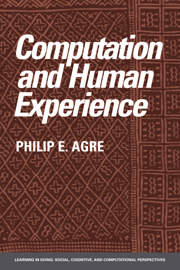Book contents
- Frontmatter
- Contents
- Preface
- 1 Introduction
- 2 Metaphor in practice
- 3 Machinery and dynamics
- 4 Abstraction and implementation
- 5 The digital abstraction
- 6 Dependency maintenance
- 7 Rule system
- 8 Planning and improvisation
- 9 Running arguments
- 10 Experiments with running arguments
- 11 Representation and indexicality
- 12 Deictic representation
- 13 Pengi
- 14 Conclusion
- Notes
- References
- Author index
- Subject index
11 - Representation and indexicality
Published online by Cambridge University Press: 07 December 2009
- Frontmatter
- Contents
- Preface
- 1 Introduction
- 2 Metaphor in practice
- 3 Machinery and dynamics
- 4 Abstraction and implementation
- 5 The digital abstraction
- 6 Dependency maintenance
- 7 Rule system
- 8 Planning and improvisation
- 9 Running arguments
- 10 Experiments with running arguments
- 11 Representation and indexicality
- 12 Deictic representation
- 13 Pengi
- 14 Conclusion
- Notes
- References
- Author index
- Subject index
Summary
World models
As an agent gets along in the world, its actions are plainly about the world in some sense. In picking up a cup, I am not just extending my forearm and adjusting my fingers: those movements can be parsimoniously described only in relation to the cup and the ways that cups are used. A conversation about a malfunctioning refrigerator, likewise, really is about that refrigerator; it is not just a series of noises or grammatical constructions. When someone is studying maps and contemplating which road to take, it is probably impossible to provide any coherent account of what that person is doing except in relation to those roads.
AI researchers have understood these phenomena in terms of representations: actions, discussions, and thoughts are held to relate to particular things in the world because they involve mental representations of those things. It can hardly be denied that people do employ representations of various sorts, from cookbooks and billboards to internalized speech and the retinotopic maps of early vision. But the mentalist computational theory of representation has been simultaneously broader and more specific. In this chapter I will discuss the nature and origins of this theory, as well as some reasons to doubt its utility as part of a theory of activity. Chapter 12 will suggest that the primordial forms of representation are best understood as facets of particular time-extended patterns of interaction with the physical and social world. Later sections of the present chapter will prepare some background for this idea by discussing indexicality (the dependence of reference on time and place) and the more fundamental phenomenon of intentionality (the “aboutness” of actions, discussions, and thoughts).
- Type
- Chapter
- Information
- Computation and Human Experience , pp. 222 - 240Publisher: Cambridge University PressPrint publication year: 1997



